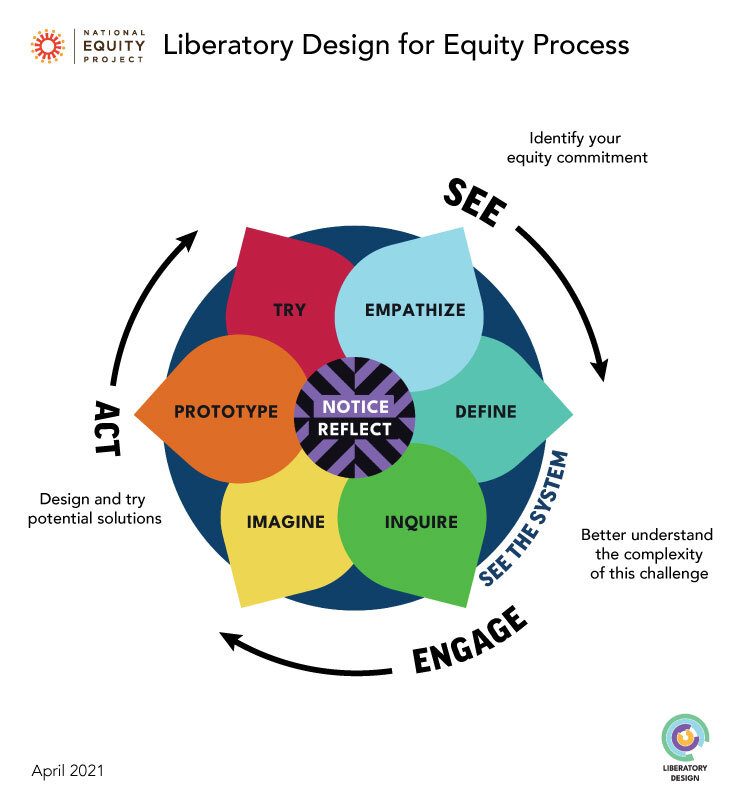For our fourth installment of our Elevate Q&A series examining issues pertinent to the philanthropic sector and nonprofits, I am chronicling my own journey to learn how to nurture a more equitable organizational culture through the use of a process called human-centered design. In Part 2 of this blog, I sit down with Tom Malarkey of the National Equity Project (NEP) to learn more about how the NEP was inspired by human-centered design thinking to develop Liberatory Design, its model for interrupting inequity.
A Human-Centered Design Approach to Equity Work
During the past year, and building on my earlier Q&A with April Walker of Philanthropy for the People, I’ve been interested in what it takes for an organization to transform its culture into a more equitable one. To that end, I read Minal Bopaiah’s excellent book on how organizations can use human-centered design to achieve a more fair and just workplace. For those of you who aren’t familiar with the  term human-centered design (I certainly wasn’t!), it is a creative problem-solving technique that was first employed in the engineering field by the Stanford University design program. It prioritizes people and considers the complex systems within which they operate. It is now widely utilized across disciplines, and as I realized, can be a thoughtful, process-oriented approach to IDEA+J work.
term human-centered design (I certainly wasn’t!), it is a creative problem-solving technique that was first employed in the engineering field by the Stanford University design program. It prioritizes people and considers the complex systems within which they operate. It is now widely utilized across disciplines, and as I realized, can be a thoughtful, process-oriented approach to IDEA+J work.
I was now eager to engage, so I began looking for some interactive opportunities, such as trainings, that would enhance this learning and provide me with more tools and resources. That’s when I came across the National Equity Project and its human-centered, Liberatory Design approach to equity work.
The National Equity Project (NEP) is a nonprofit, social impact organization committed to increasing the capacity of people to achieve thriving, self-determining, educated and just communities. NEP focuses on systemic change through leadership development, by supporting leaders across systems to build culture, conditions, and competencies for excellence and equity in school districts, organizations, foundations, and communities.
What is Liberatory Design? Think Mindfulness Practice for Equity
I was excited to discover that The National Equity Project had developed a creative way of problem-solving to address equity challenges. Team members can seek to SEE and understand the territory they are navigating, to ENGAGE others to make meaning of the current situation, and then ACT to address the equity challenge and learn from that action.
 The power of Liberatory Design comes from its ability to help us better understand equity challenges in highly complex interconnected systems, to see ways systems of oppression are impacting our context, to root our decision-making in our values, to combat status quo behavior with deep self-reflection, and to learn and change in a fast-moving, meaningful way. The way forward is led by noticing, experimenting, learning, reflecting, and repeating. Liberatory Design is structured to build equity leadership capacity to create real change with the communities within which you work.The process itself, as well as the outcomes, are building towards greater collective liberation. It recognizes that the required mindset is not one where work is linear or where boxes are ticked off in a sequential fashion.
The power of Liberatory Design comes from its ability to help us better understand equity challenges in highly complex interconnected systems, to see ways systems of oppression are impacting our context, to root our decision-making in our values, to combat status quo behavior with deep self-reflection, and to learn and change in a fast-moving, meaningful way. The way forward is led by noticing, experimenting, learning, reflecting, and repeating. Liberatory Design is structured to build equity leadership capacity to create real change with the communities within which you work.The process itself, as well as the outcomes, are building towards greater collective liberation. It recognizes that the required mindset is not one where work is linear or where boxes are ticked off in a sequential fashion.
With my Elevate professional development dollars, I signed up for a three-hour webinar, Introduction to Liberatory Design (note that NEP also offers a more comprehensive six-week training!), where I was able to engage in small group discussions and network with educators as well as nonprofit and foundation leaders. During the workshop, I realized how much the Design mindsets are similar to mindfulness practice– that they are a continuous process of learning and extending ourselves. It also struck me that they are really about ways to live and could be applied beyond working environments.
Liberatory Design in Action
So how has Liberatory Design been used by organizations to address their equity challenges and create new opportunities? Here are just a few examples:
 The Kenneth Rainin Foundation engaged Liberatory Design to be more responsive to its community and its grantees and to improve early childhood literacy in the Bay Area city it serves.
The Kenneth Rainin Foundation engaged Liberatory Design to be more responsive to its community and its grantees and to improve early childhood literacy in the Bay Area city it serves. - A Charter School Management Organization applied Liberatory Design to transform its staff into one that was more reflective of the students and families it serves, with attention to BIPOC recruiting and retention barriers and leadership development.
- The Northwest Regional Education Service District, which serves four counties in Northwest Oregon, formed several site-based equity learning teams trained in Liberatory Design to build their internal culture around equity action, move forward on an antiracist multicultural continuum, and improve its systems to better support the community.
Interested in learning more about Liberatory Design and what it could do for your organization? Download the free English or Spanish deck of cards here. And watch this space for Part 2 of this blog, where I sit down with one of Liberatory Design’s originators, Tom Malarkey of the National Equity Project.
About the Author:

Johnisha Levi











 term human-centered design (I certainly wasn’t!), it is a creative problem-solving technique that was first employed in the engineering field by the Stanford University design program. It prioritizes people and considers the complex systems within which they operate. It is now widely utilized across disciplines, and as I realized, can be a thoughtful, process-oriented approach to IDEA+J work.
term human-centered design (I certainly wasn’t!), it is a creative problem-solving technique that was first employed in the engineering field by the Stanford University design program. It prioritizes people and considers the complex systems within which they operate. It is now widely utilized across disciplines, and as I realized, can be a thoughtful, process-oriented approach to IDEA+J work.  The power of Liberatory Design comes from its ability to help us better understand equity challenges in highly complex interconnected systems, to see ways systems of oppression are impacting our context, to root our decision-making in our values, to combat status quo behavior with deep self-reflection, and to learn and change in a fast-moving, meaningful way. The way forward is led by noticing, experimenting, learning, reflecting, and repeating. Liberatory Design is structured to build equity leadership capacity to create real change with the communities within which you work.The process itself, as well as the outcomes, are building towards greater collective liberation. It recognizes that the required mindset is not one where work is linear or where boxes are ticked off in a sequential fashion.
The power of Liberatory Design comes from its ability to help us better understand equity challenges in highly complex interconnected systems, to see ways systems of oppression are impacting our context, to root our decision-making in our values, to combat status quo behavior with deep self-reflection, and to learn and change in a fast-moving, meaningful way. The way forward is led by noticing, experimenting, learning, reflecting, and repeating. Liberatory Design is structured to build equity leadership capacity to create real change with the communities within which you work.The process itself, as well as the outcomes, are building towards greater collective liberation. It recognizes that the required mindset is not one where work is linear or where boxes are ticked off in a sequential fashion.  The
The 





